Employee Emotional Labor & Consumer Purchase Behavior in Canada
VerifiedAdded on 2022/08/19
|13
|2128
|16
Report
AI Summary
This research paper presents an empirical study on the relationship between employee emotional labor and consumer purchasing behavior in Canadian retail stores. The study begins by outlining supporting theories, including the theory of reasoned action, hierarchy of need theory, and Hawkins Stern Impulse Buying theory, to provide a framework for understanding consumer behavior. The research employs a quantitative methodology, utilizing surveys to collect primary data from respondents in various retail stores across Toronto and Alberta. Key variables such as price, location, emotional appeals, and the effects of advertisements are analyzed to determine their influence on consumer decisions. Findings indicate that price and location significantly impact purchase behavior, while emotional appeals show a lesser effect. Advertisements are identified as a critical medium for influencing consumer choices. The paper concludes by summarizing the findings and their implications for understanding consumer behavior in the context of employee emotional labor within the Canadian retail landscape.
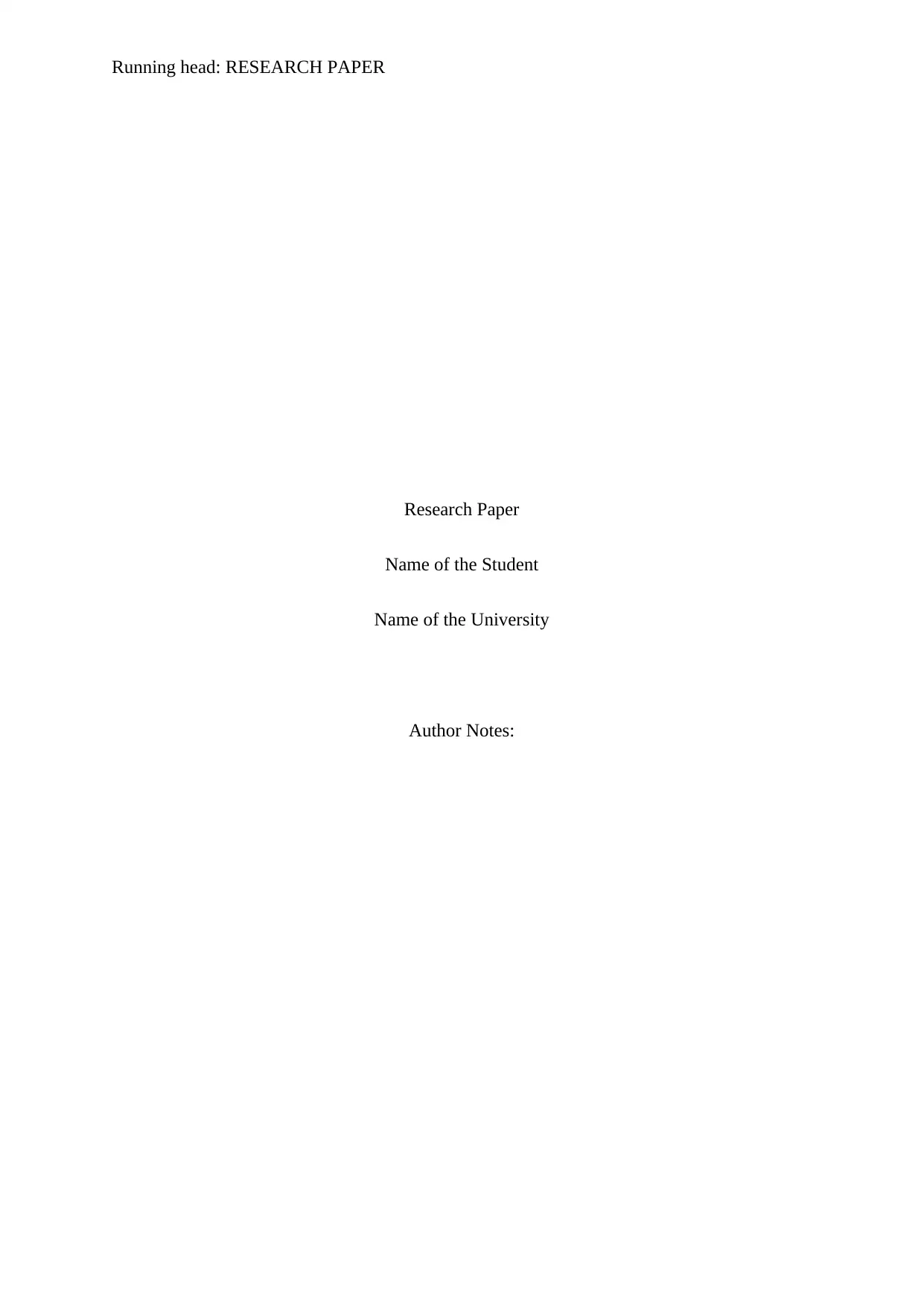
Running head: RESEARCH PAPER
Research Paper
Name of the Student
Name of the University
Author Notes:
Research Paper
Name of the Student
Name of the University
Author Notes:
Paraphrase This Document
Need a fresh take? Get an instant paraphrase of this document with our AI Paraphraser
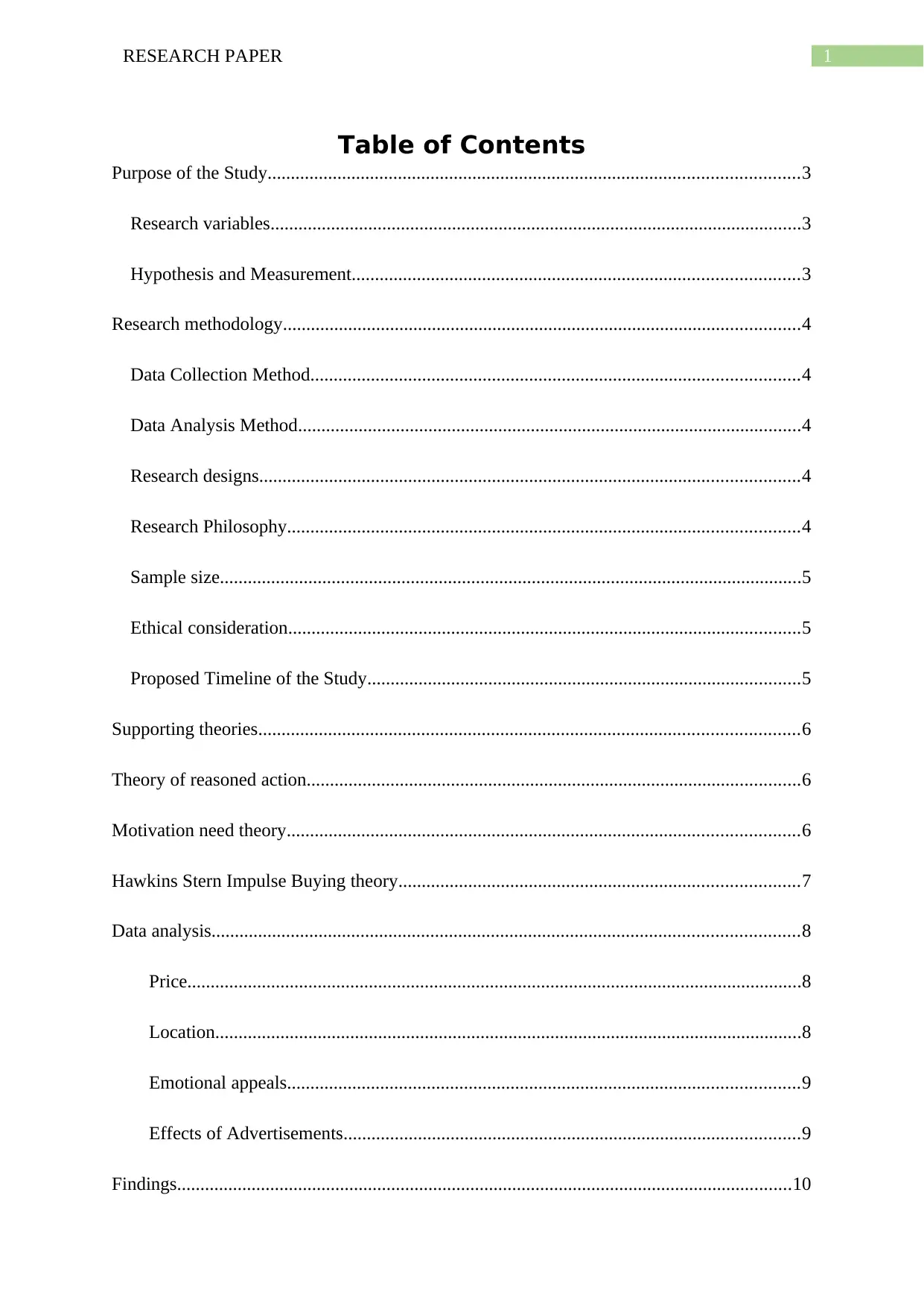
1RESEARCH PAPER
Table of Contents
Purpose of the Study..................................................................................................................3
Research variables..................................................................................................................3
Hypothesis and Measurement................................................................................................3
Research methodology...............................................................................................................4
Data Collection Method.........................................................................................................4
Data Analysis Method............................................................................................................4
Research designs....................................................................................................................4
Research Philosophy..............................................................................................................4
Sample size.............................................................................................................................5
Ethical consideration..............................................................................................................5
Proposed Timeline of the Study.............................................................................................5
Supporting theories....................................................................................................................6
Theory of reasoned action..........................................................................................................6
Motivation need theory..............................................................................................................6
Hawkins Stern Impulse Buying theory......................................................................................7
Data analysis..............................................................................................................................8
Price....................................................................................................................................8
Location..............................................................................................................................8
Emotional appeals..............................................................................................................9
Effects of Advertisements..................................................................................................9
Findings....................................................................................................................................10
Table of Contents
Purpose of the Study..................................................................................................................3
Research variables..................................................................................................................3
Hypothesis and Measurement................................................................................................3
Research methodology...............................................................................................................4
Data Collection Method.........................................................................................................4
Data Analysis Method............................................................................................................4
Research designs....................................................................................................................4
Research Philosophy..............................................................................................................4
Sample size.............................................................................................................................5
Ethical consideration..............................................................................................................5
Proposed Timeline of the Study.............................................................................................5
Supporting theories....................................................................................................................6
Theory of reasoned action..........................................................................................................6
Motivation need theory..............................................................................................................6
Hawkins Stern Impulse Buying theory......................................................................................7
Data analysis..............................................................................................................................8
Price....................................................................................................................................8
Location..............................................................................................................................8
Emotional appeals..............................................................................................................9
Effects of Advertisements..................................................................................................9
Findings....................................................................................................................................10
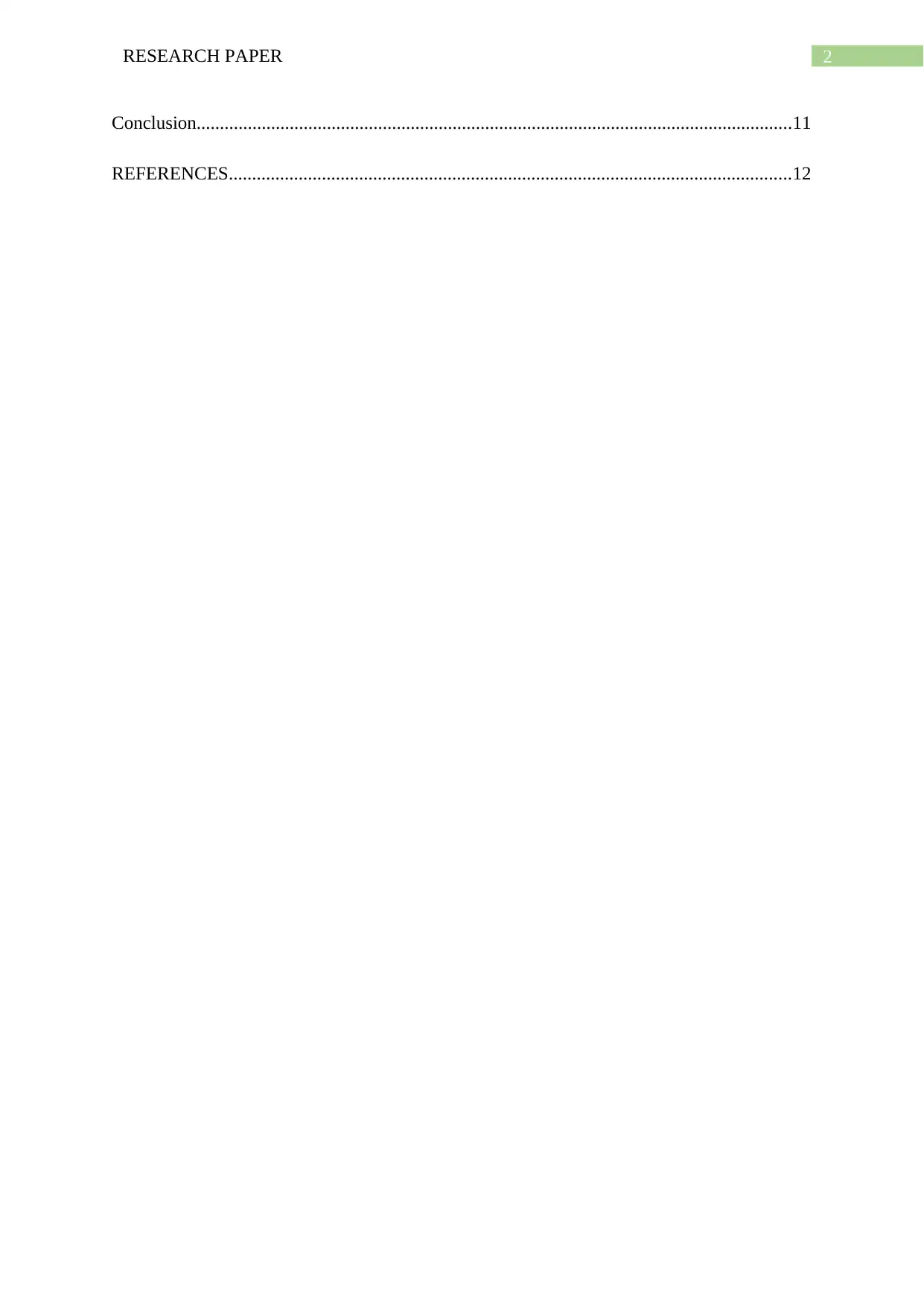
2RESEARCH PAPER
Conclusion................................................................................................................................11
REFERENCES.........................................................................................................................12
Conclusion................................................................................................................................11
REFERENCES.........................................................................................................................12
⊘ This is a preview!⊘
Do you want full access?
Subscribe today to unlock all pages.

Trusted by 1+ million students worldwide
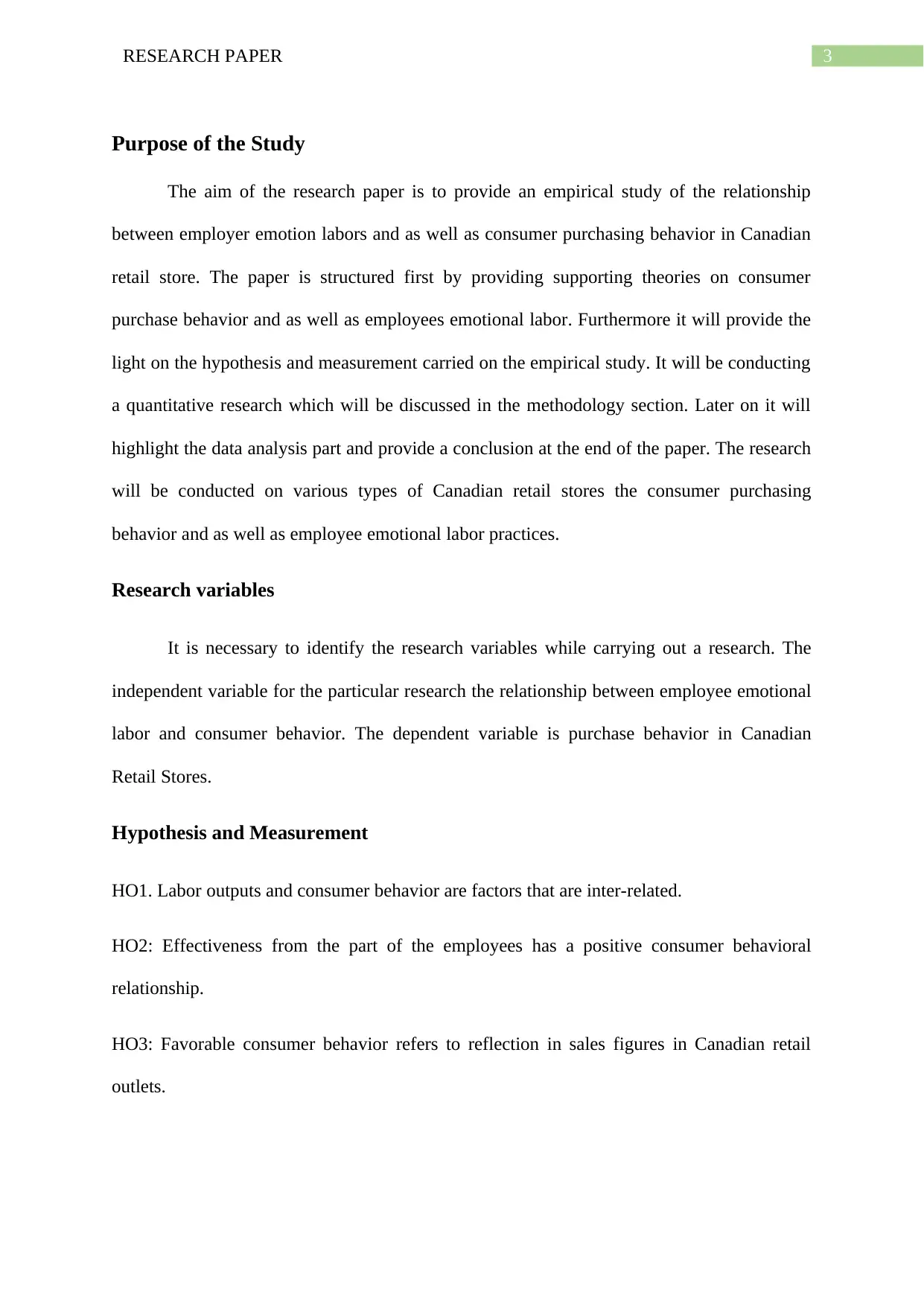
3RESEARCH PAPER
Purpose of the Study
The aim of the research paper is to provide an empirical study of the relationship
between employer emotion labors and as well as consumer purchasing behavior in Canadian
retail store. The paper is structured first by providing supporting theories on consumer
purchase behavior and as well as employees emotional labor. Furthermore it will provide the
light on the hypothesis and measurement carried on the empirical study. It will be conducting
a quantitative research which will be discussed in the methodology section. Later on it will
highlight the data analysis part and provide a conclusion at the end of the paper. The research
will be conducted on various types of Canadian retail stores the consumer purchasing
behavior and as well as employee emotional labor practices.
Research variables
It is necessary to identify the research variables while carrying out a research. The
independent variable for the particular research the relationship between employee emotional
labor and consumer behavior. The dependent variable is purchase behavior in Canadian
Retail Stores.
Hypothesis and Measurement
HO1. Labor outputs and consumer behavior are factors that are inter-related.
HO2: Effectiveness from the part of the employees has a positive consumer behavioral
relationship.
HO3: Favorable consumer behavior refers to reflection in sales figures in Canadian retail
outlets.
Purpose of the Study
The aim of the research paper is to provide an empirical study of the relationship
between employer emotion labors and as well as consumer purchasing behavior in Canadian
retail store. The paper is structured first by providing supporting theories on consumer
purchase behavior and as well as employees emotional labor. Furthermore it will provide the
light on the hypothesis and measurement carried on the empirical study. It will be conducting
a quantitative research which will be discussed in the methodology section. Later on it will
highlight the data analysis part and provide a conclusion at the end of the paper. The research
will be conducted on various types of Canadian retail stores the consumer purchasing
behavior and as well as employee emotional labor practices.
Research variables
It is necessary to identify the research variables while carrying out a research. The
independent variable for the particular research the relationship between employee emotional
labor and consumer behavior. The dependent variable is purchase behavior in Canadian
Retail Stores.
Hypothesis and Measurement
HO1. Labor outputs and consumer behavior are factors that are inter-related.
HO2: Effectiveness from the part of the employees has a positive consumer behavioral
relationship.
HO3: Favorable consumer behavior refers to reflection in sales figures in Canadian retail
outlets.
Paraphrase This Document
Need a fresh take? Get an instant paraphrase of this document with our AI Paraphraser
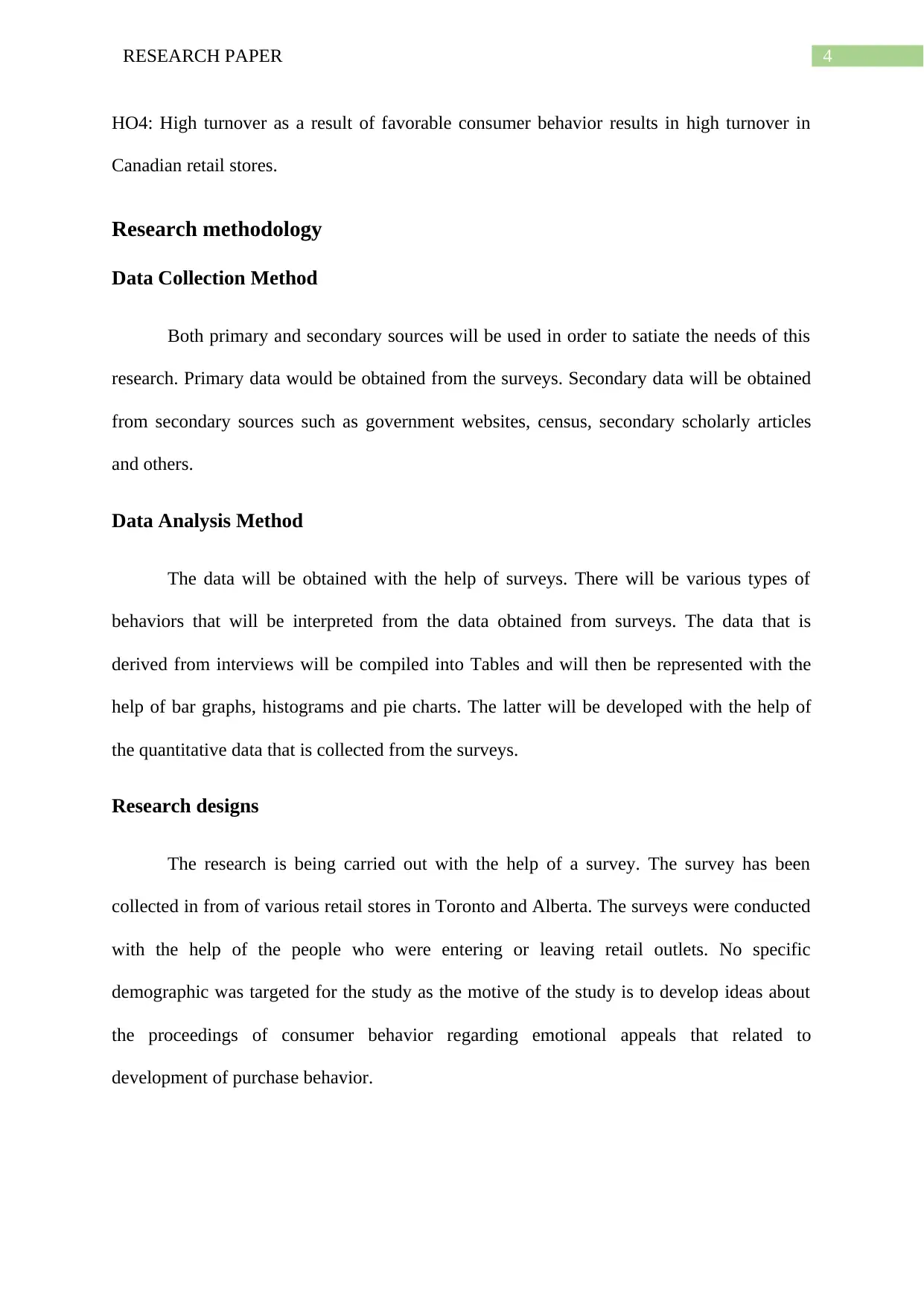
4RESEARCH PAPER
HO4: High turnover as a result of favorable consumer behavior results in high turnover in
Canadian retail stores.
Research methodology
Data Collection Method
Both primary and secondary sources will be used in order to satiate the needs of this
research. Primary data would be obtained from the surveys. Secondary data will be obtained
from secondary sources such as government websites, census, secondary scholarly articles
and others.
Data Analysis Method
The data will be obtained with the help of surveys. There will be various types of
behaviors that will be interpreted from the data obtained from surveys. The data that is
derived from interviews will be compiled into Tables and will then be represented with the
help of bar graphs, histograms and pie charts. The latter will be developed with the help of
the quantitative data that is collected from the surveys.
Research designs
The research is being carried out with the help of a survey. The survey has been
collected in from of various retail stores in Toronto and Alberta. The surveys were conducted
with the help of the people who were entering or leaving retail outlets. No specific
demographic was targeted for the study as the motive of the study is to develop ideas about
the proceedings of consumer behavior regarding emotional appeals that related to
development of purchase behavior.
HO4: High turnover as a result of favorable consumer behavior results in high turnover in
Canadian retail stores.
Research methodology
Data Collection Method
Both primary and secondary sources will be used in order to satiate the needs of this
research. Primary data would be obtained from the surveys. Secondary data will be obtained
from secondary sources such as government websites, census, secondary scholarly articles
and others.
Data Analysis Method
The data will be obtained with the help of surveys. There will be various types of
behaviors that will be interpreted from the data obtained from surveys. The data that is
derived from interviews will be compiled into Tables and will then be represented with the
help of bar graphs, histograms and pie charts. The latter will be developed with the help of
the quantitative data that is collected from the surveys.
Research designs
The research is being carried out with the help of a survey. The survey has been
collected in from of various retail stores in Toronto and Alberta. The surveys were conducted
with the help of the people who were entering or leaving retail outlets. No specific
demographic was targeted for the study as the motive of the study is to develop ideas about
the proceedings of consumer behavior regarding emotional appeals that related to
development of purchase behavior.
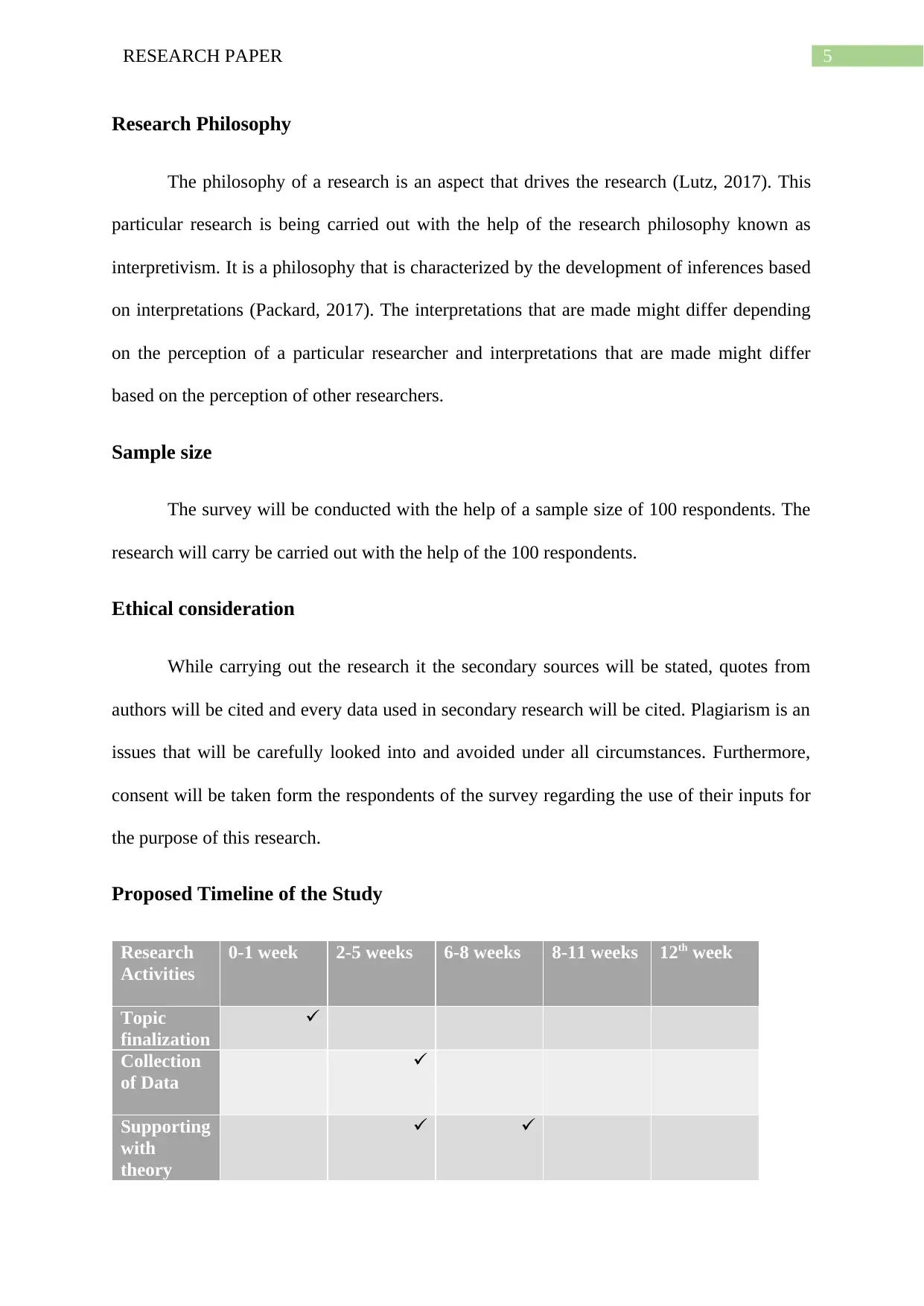
5RESEARCH PAPER
Research Philosophy
The philosophy of a research is an aspect that drives the research (Lutz, 2017). This
particular research is being carried out with the help of the research philosophy known as
interpretivism. It is a philosophy that is characterized by the development of inferences based
on interpretations (Packard, 2017). The interpretations that are made might differ depending
on the perception of a particular researcher and interpretations that are made might differ
based on the perception of other researchers.
Sample size
The survey will be conducted with the help of a sample size of 100 respondents. The
research will carry be carried out with the help of the 100 respondents.
Ethical consideration
While carrying out the research it the secondary sources will be stated, quotes from
authors will be cited and every data used in secondary research will be cited. Plagiarism is an
issues that will be carefully looked into and avoided under all circumstances. Furthermore,
consent will be taken form the respondents of the survey regarding the use of their inputs for
the purpose of this research.
Proposed Timeline of the Study
Research
Activities
0-1 week 2-5 weeks 6-8 weeks 8-11 weeks 12th week
Topic
finalization
Collection
of Data
Supporting
with
theory
Research Philosophy
The philosophy of a research is an aspect that drives the research (Lutz, 2017). This
particular research is being carried out with the help of the research philosophy known as
interpretivism. It is a philosophy that is characterized by the development of inferences based
on interpretations (Packard, 2017). The interpretations that are made might differ depending
on the perception of a particular researcher and interpretations that are made might differ
based on the perception of other researchers.
Sample size
The survey will be conducted with the help of a sample size of 100 respondents. The
research will carry be carried out with the help of the 100 respondents.
Ethical consideration
While carrying out the research it the secondary sources will be stated, quotes from
authors will be cited and every data used in secondary research will be cited. Plagiarism is an
issues that will be carefully looked into and avoided under all circumstances. Furthermore,
consent will be taken form the respondents of the survey regarding the use of their inputs for
the purpose of this research.
Proposed Timeline of the Study
Research
Activities
0-1 week 2-5 weeks 6-8 weeks 8-11 weeks 12th week
Topic
finalization
Collection
of Data
Supporting
with
theory
⊘ This is a preview!⊘
Do you want full access?
Subscribe today to unlock all pages.

Trusted by 1+ million students worldwide
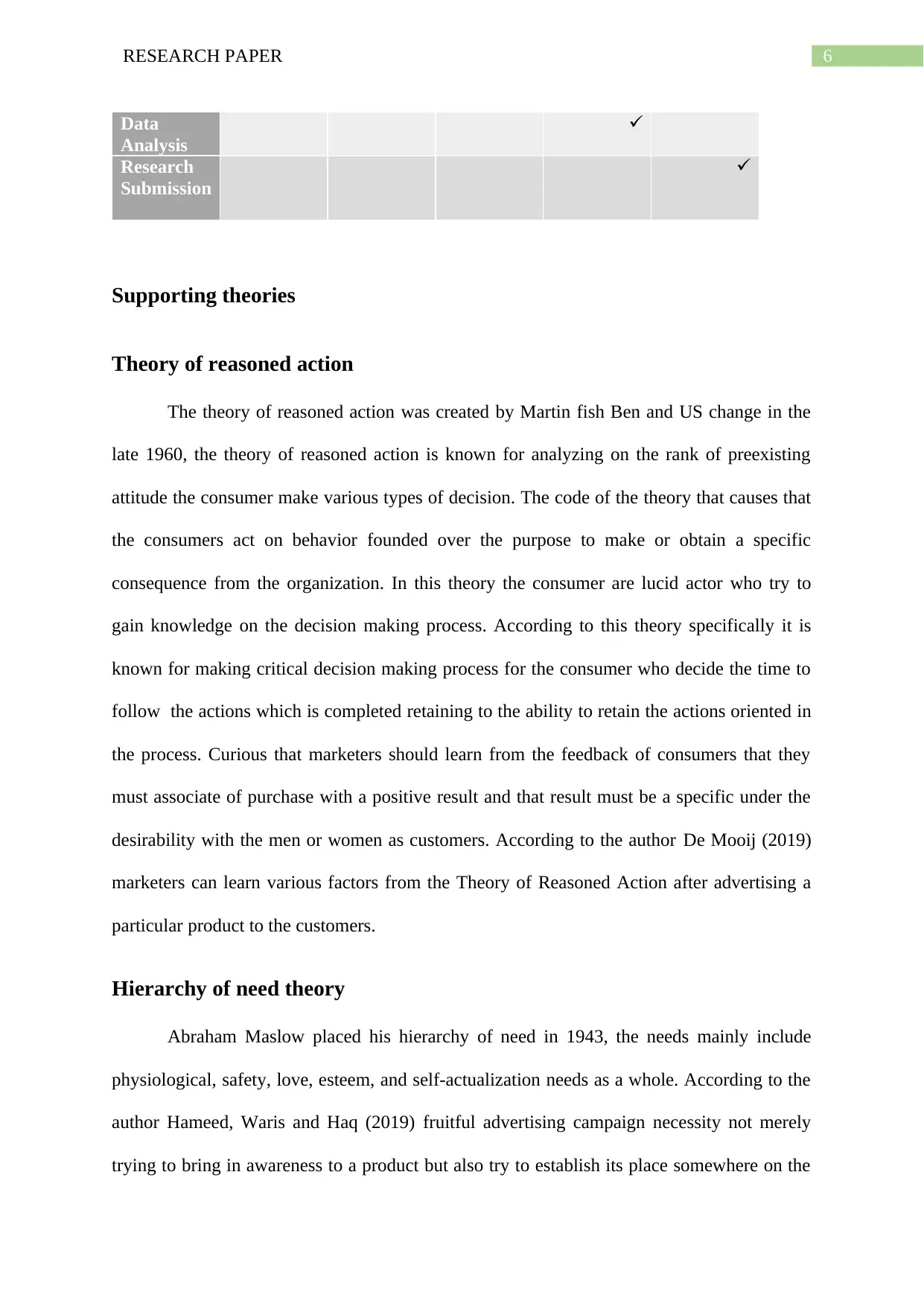
6RESEARCH PAPER
Data
Analysis
Research
Submission
Supporting theories
Theory of reasoned action
The theory of reasoned action was created by Martin fish Ben and US change in the
late 1960, the theory of reasoned action is known for analyzing on the rank of preexisting
attitude the consumer make various types of decision. The code of the theory that causes that
the consumers act on behavior founded over the purpose to make or obtain a specific
consequence from the organization. In this theory the consumer are lucid actor who try to
gain knowledge on the decision making process. According to this theory specifically it is
known for making critical decision making process for the consumer who decide the time to
follow the actions which is completed retaining to the ability to retain the actions oriented in
the process. Curious that marketers should learn from the feedback of consumers that they
must associate of purchase with a positive result and that result must be a specific under the
desirability with the men or women as customers. According to the author De Mooij (2019)
marketers can learn various factors from the Theory of Reasoned Action after advertising a
particular product to the customers.
Hierarchy of need theory
Abraham Maslow placed his hierarchy of need in 1943, the needs mainly include
physiological, safety, love, esteem, and self-actualization needs as a whole. According to the
author Hameed, Waris and Haq (2019) fruitful advertising campaign necessity not merely
trying to bring in awareness to a product but also try to establish its place somewhere on the
Data
Analysis
Research
Submission
Supporting theories
Theory of reasoned action
The theory of reasoned action was created by Martin fish Ben and US change in the
late 1960, the theory of reasoned action is known for analyzing on the rank of preexisting
attitude the consumer make various types of decision. The code of the theory that causes that
the consumers act on behavior founded over the purpose to make or obtain a specific
consequence from the organization. In this theory the consumer are lucid actor who try to
gain knowledge on the decision making process. According to this theory specifically it is
known for making critical decision making process for the consumer who decide the time to
follow the actions which is completed retaining to the ability to retain the actions oriented in
the process. Curious that marketers should learn from the feedback of consumers that they
must associate of purchase with a positive result and that result must be a specific under the
desirability with the men or women as customers. According to the author De Mooij (2019)
marketers can learn various factors from the Theory of Reasoned Action after advertising a
particular product to the customers.
Hierarchy of need theory
Abraham Maslow placed his hierarchy of need in 1943, the needs mainly include
physiological, safety, love, esteem, and self-actualization needs as a whole. According to the
author Hameed, Waris and Haq (2019) fruitful advertising campaign necessity not merely
trying to bring in awareness to a product but also try to establish its place somewhere on the
Paraphrase This Document
Need a fresh take? Get an instant paraphrase of this document with our AI Paraphraser
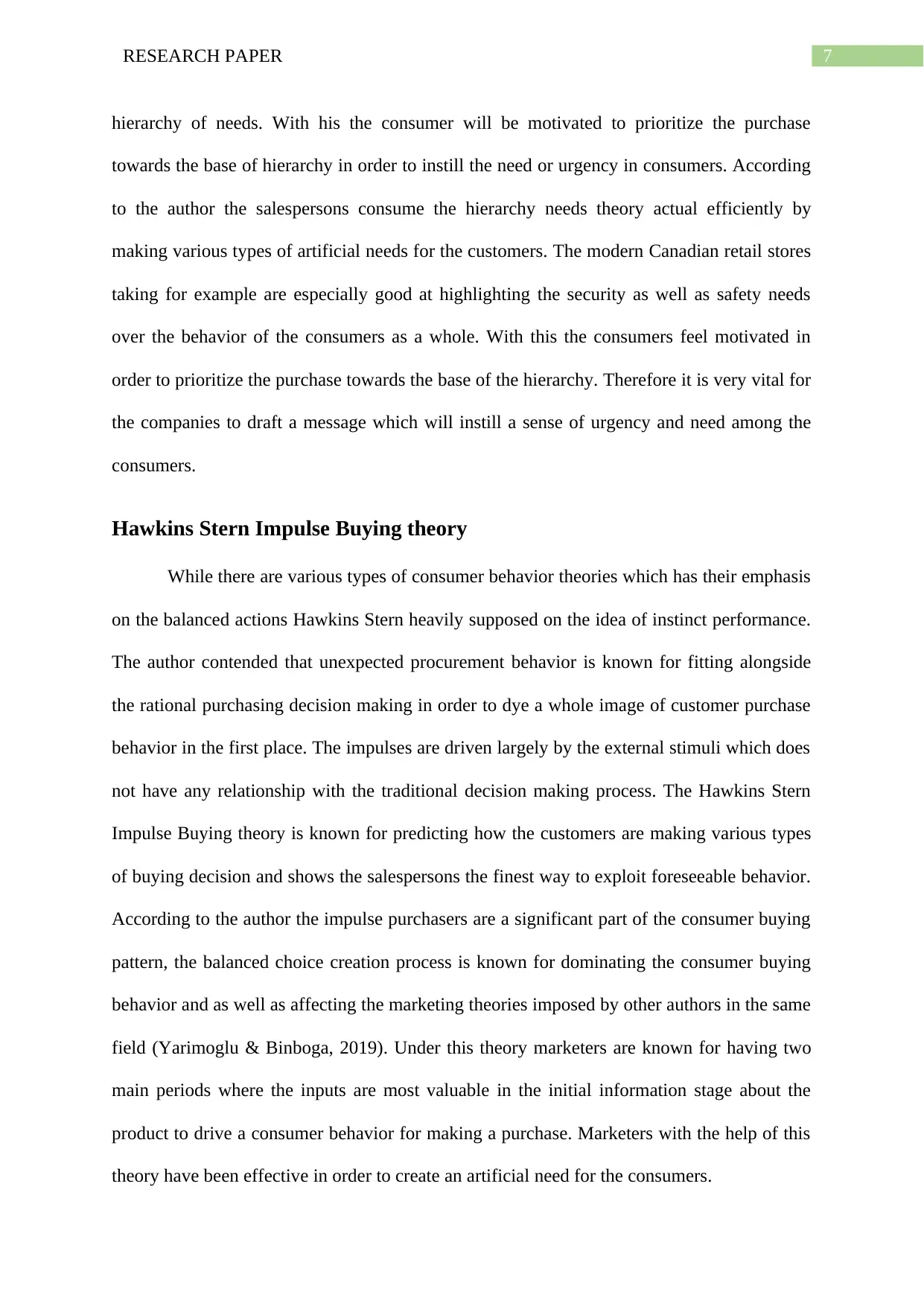
7RESEARCH PAPER
hierarchy of needs. With his the consumer will be motivated to prioritize the purchase
towards the base of hierarchy in order to instill the need or urgency in consumers. According
to the author the salespersons consume the hierarchy needs theory actual efficiently by
making various types of artificial needs for the customers. The modern Canadian retail stores
taking for example are especially good at highlighting the security as well as safety needs
over the behavior of the consumers as a whole. With this the consumers feel motivated in
order to prioritize the purchase towards the base of the hierarchy. Therefore it is very vital for
the companies to draft a message which will instill a sense of urgency and need among the
consumers.
Hawkins Stern Impulse Buying theory
While there are various types of consumer behavior theories which has their emphasis
on the balanced actions Hawkins Stern heavily supposed on the idea of instinct performance.
The author contended that unexpected procurement behavior is known for fitting alongside
the rational purchasing decision making in order to dye a whole image of customer purchase
behavior in the first place. The impulses are driven largely by the external stimuli which does
not have any relationship with the traditional decision making process. The Hawkins Stern
Impulse Buying theory is known for predicting how the customers are making various types
of buying decision and shows the salespersons the finest way to exploit foreseeable behavior.
According to the author the impulse purchasers are a significant part of the consumer buying
pattern, the balanced choice creation process is known for dominating the consumer buying
behavior and as well as affecting the marketing theories imposed by other authors in the same
field (Yarimoglu & Binboga, 2019). Under this theory marketers are known for having two
main periods where the inputs are most valuable in the initial information stage about the
product to drive a consumer behavior for making a purchase. Marketers with the help of this
theory have been effective in order to create an artificial need for the consumers.
hierarchy of needs. With his the consumer will be motivated to prioritize the purchase
towards the base of hierarchy in order to instill the need or urgency in consumers. According
to the author the salespersons consume the hierarchy needs theory actual efficiently by
making various types of artificial needs for the customers. The modern Canadian retail stores
taking for example are especially good at highlighting the security as well as safety needs
over the behavior of the consumers as a whole. With this the consumers feel motivated in
order to prioritize the purchase towards the base of the hierarchy. Therefore it is very vital for
the companies to draft a message which will instill a sense of urgency and need among the
consumers.
Hawkins Stern Impulse Buying theory
While there are various types of consumer behavior theories which has their emphasis
on the balanced actions Hawkins Stern heavily supposed on the idea of instinct performance.
The author contended that unexpected procurement behavior is known for fitting alongside
the rational purchasing decision making in order to dye a whole image of customer purchase
behavior in the first place. The impulses are driven largely by the external stimuli which does
not have any relationship with the traditional decision making process. The Hawkins Stern
Impulse Buying theory is known for predicting how the customers are making various types
of buying decision and shows the salespersons the finest way to exploit foreseeable behavior.
According to the author the impulse purchasers are a significant part of the consumer buying
pattern, the balanced choice creation process is known for dominating the consumer buying
behavior and as well as affecting the marketing theories imposed by other authors in the same
field (Yarimoglu & Binboga, 2019). Under this theory marketers are known for having two
main periods where the inputs are most valuable in the initial information stage about the
product to drive a consumer behavior for making a purchase. Marketers with the help of this
theory have been effective in order to create an artificial need for the consumers.
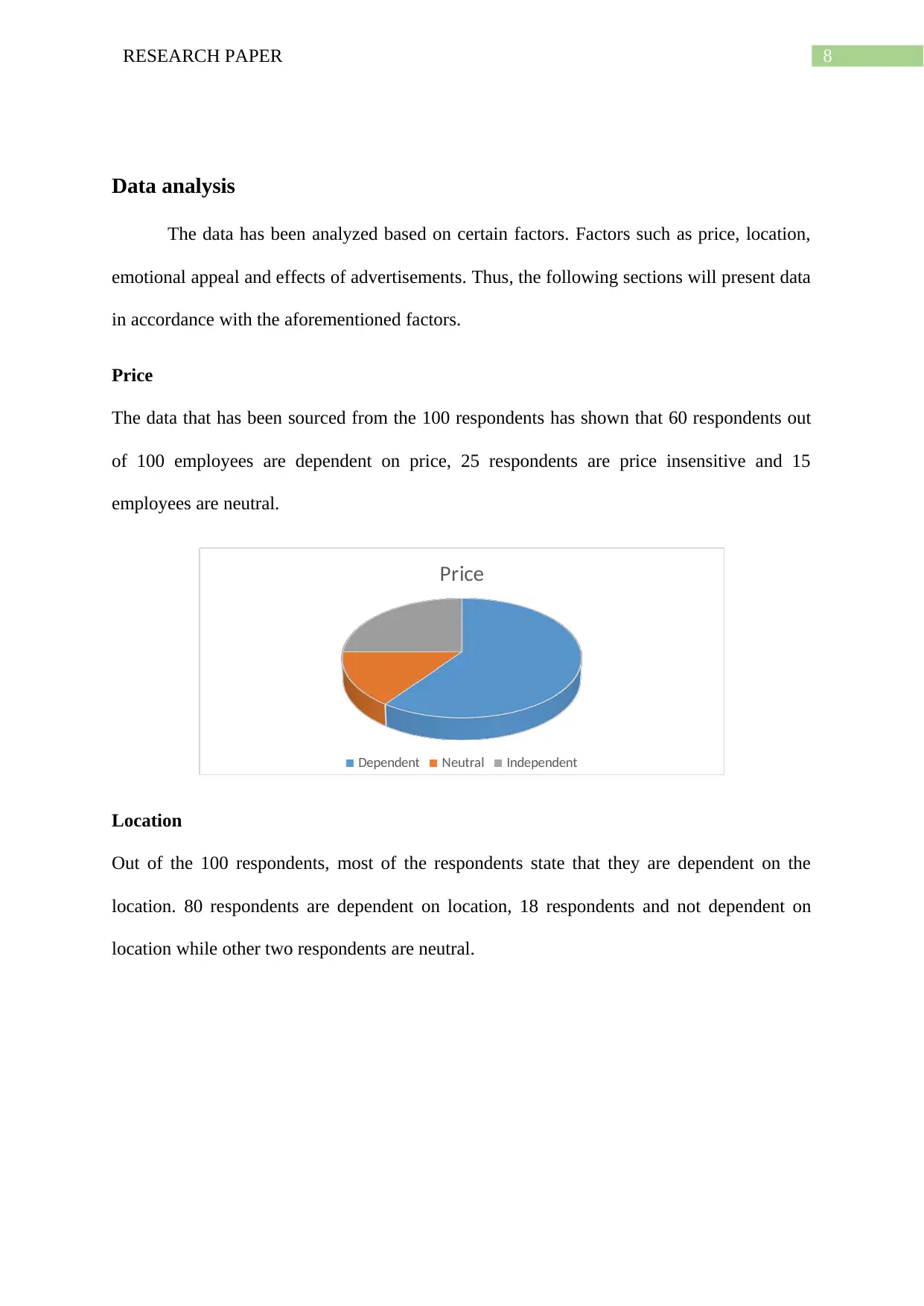
8RESEARCH PAPER
Data analysis
The data has been analyzed based on certain factors. Factors such as price, location,
emotional appeal and effects of advertisements. Thus, the following sections will present data
in accordance with the aforementioned factors.
Price
The data that has been sourced from the 100 respondents has shown that 60 respondents out
of 100 employees are dependent on price, 25 respondents are price insensitive and 15
employees are neutral.
Price
Dependent Neutral Independent
Location
Out of the 100 respondents, most of the respondents state that they are dependent on the
location. 80 respondents are dependent on location, 18 respondents and not dependent on
location while other two respondents are neutral.
Data analysis
The data has been analyzed based on certain factors. Factors such as price, location,
emotional appeal and effects of advertisements. Thus, the following sections will present data
in accordance with the aforementioned factors.
Price
The data that has been sourced from the 100 respondents has shown that 60 respondents out
of 100 employees are dependent on price, 25 respondents are price insensitive and 15
employees are neutral.
Price
Dependent Neutral Independent
Location
Out of the 100 respondents, most of the respondents state that they are dependent on the
location. 80 respondents are dependent on location, 18 respondents and not dependent on
location while other two respondents are neutral.
⊘ This is a preview!⊘
Do you want full access?
Subscribe today to unlock all pages.

Trusted by 1+ million students worldwide
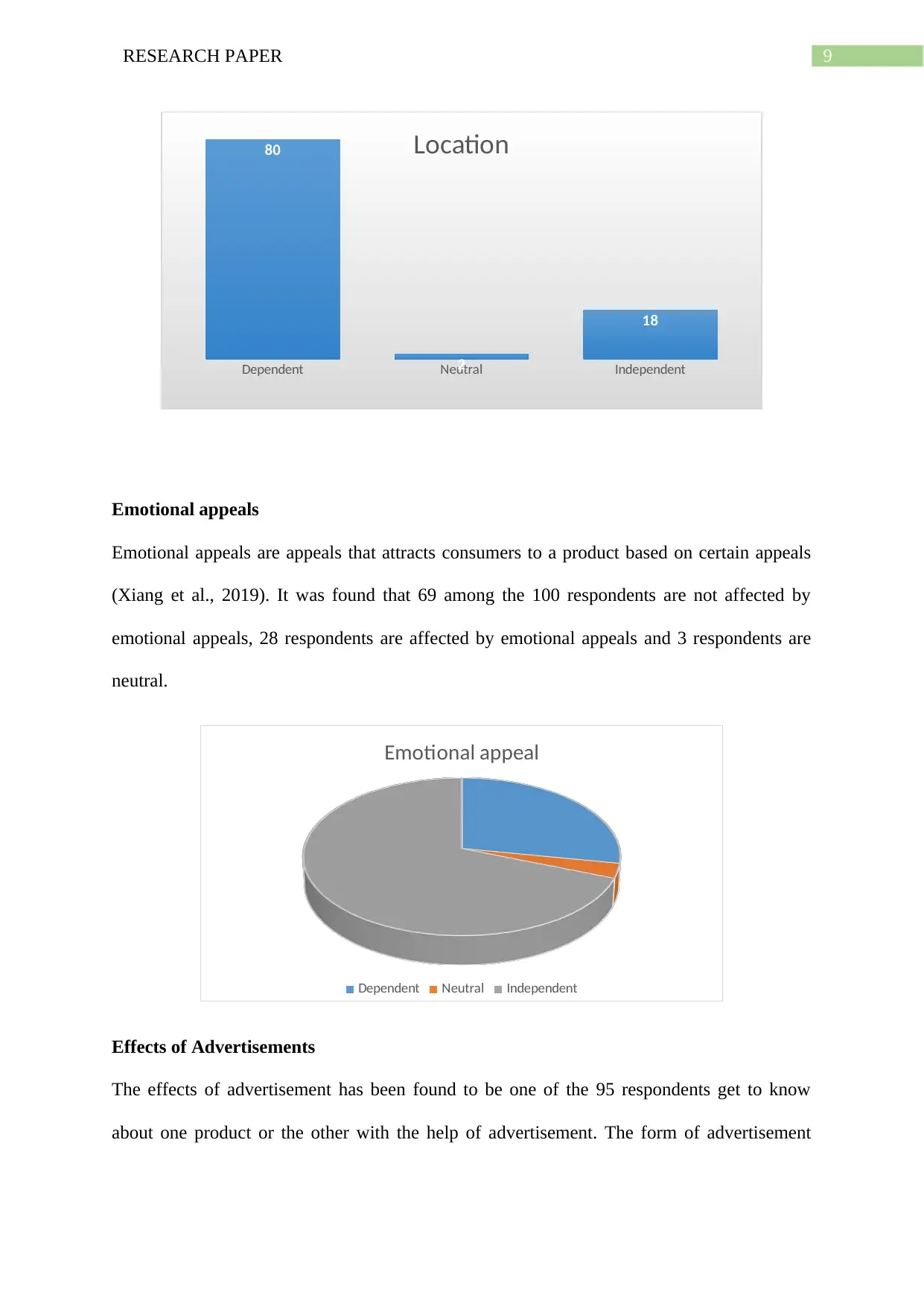
9RESEARCH PAPER
Dependent Neutral Independent
80
2
18
Location
Emotional appeals
Emotional appeals are appeals that attracts consumers to a product based on certain appeals
(Xiang et al., 2019). It was found that 69 among the 100 respondents are not affected by
emotional appeals, 28 respondents are affected by emotional appeals and 3 respondents are
neutral.
Emotional appeal
Dependent Neutral Independent
Effects of Advertisements
The effects of advertisement has been found to be one of the 95 respondents get to know
about one product or the other with the help of advertisement. The form of advertisement
Dependent Neutral Independent
80
2
18
Location
Emotional appeals
Emotional appeals are appeals that attracts consumers to a product based on certain appeals
(Xiang et al., 2019). It was found that 69 among the 100 respondents are not affected by
emotional appeals, 28 respondents are affected by emotional appeals and 3 respondents are
neutral.
Emotional appeal
Dependent Neutral Independent
Effects of Advertisements
The effects of advertisement has been found to be one of the 95 respondents get to know
about one product or the other with the help of advertisement. The form of advertisement
Paraphrase This Document
Need a fresh take? Get an instant paraphrase of this document with our AI Paraphraser
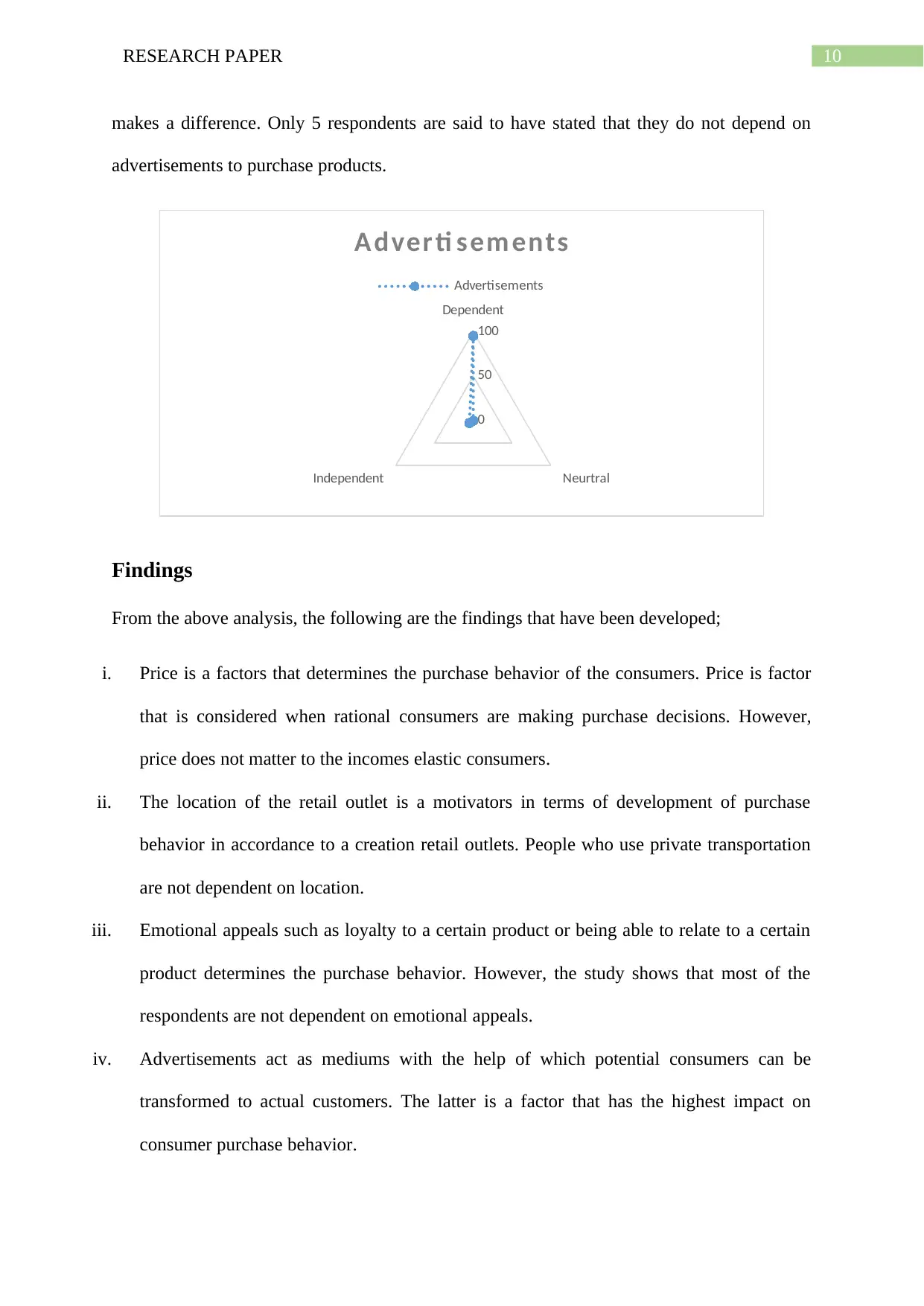
10RESEARCH PAPER
makes a difference. Only 5 respondents are said to have stated that they do not depend on
advertisements to purchase products.
Dependent
NeurtralIndependent
0
50
100
Adver ti sem ents
Advertisements
Findings
From the above analysis, the following are the findings that have been developed;
i. Price is a factors that determines the purchase behavior of the consumers. Price is factor
that is considered when rational consumers are making purchase decisions. However,
price does not matter to the incomes elastic consumers.
ii. The location of the retail outlet is a motivators in terms of development of purchase
behavior in accordance to a creation retail outlets. People who use private transportation
are not dependent on location.
iii. Emotional appeals such as loyalty to a certain product or being able to relate to a certain
product determines the purchase behavior. However, the study shows that most of the
respondents are not dependent on emotional appeals.
iv. Advertisements act as mediums with the help of which potential consumers can be
transformed to actual customers. The latter is a factor that has the highest impact on
consumer purchase behavior.
makes a difference. Only 5 respondents are said to have stated that they do not depend on
advertisements to purchase products.
Dependent
NeurtralIndependent
0
50
100
Adver ti sem ents
Advertisements
Findings
From the above analysis, the following are the findings that have been developed;
i. Price is a factors that determines the purchase behavior of the consumers. Price is factor
that is considered when rational consumers are making purchase decisions. However,
price does not matter to the incomes elastic consumers.
ii. The location of the retail outlet is a motivators in terms of development of purchase
behavior in accordance to a creation retail outlets. People who use private transportation
are not dependent on location.
iii. Emotional appeals such as loyalty to a certain product or being able to relate to a certain
product determines the purchase behavior. However, the study shows that most of the
respondents are not dependent on emotional appeals.
iv. Advertisements act as mediums with the help of which potential consumers can be
transformed to actual customers. The latter is a factor that has the highest impact on
consumer purchase behavior.
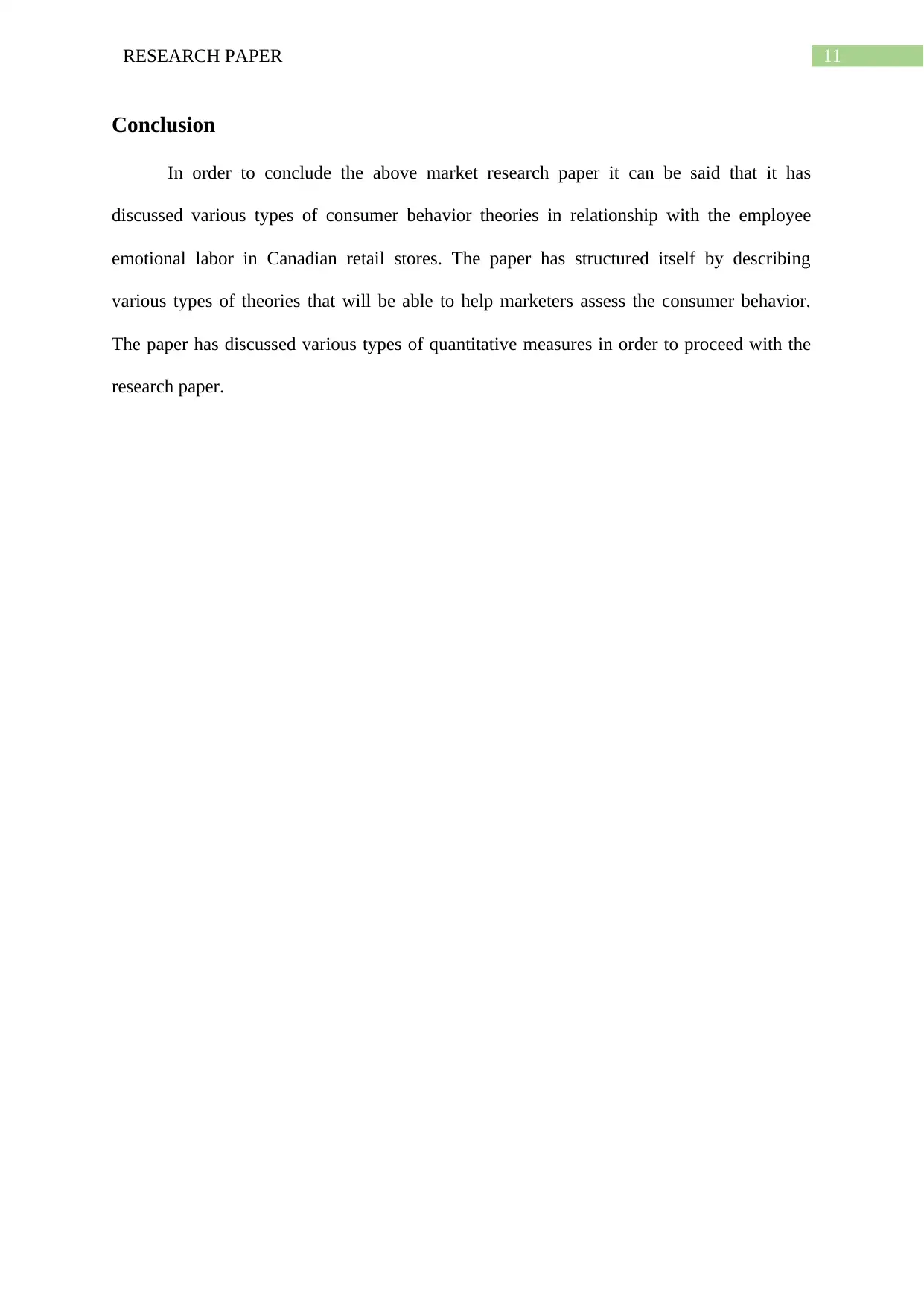
11RESEARCH PAPER
Conclusion
In order to conclude the above market research paper it can be said that it has
discussed various types of consumer behavior theories in relationship with the employee
emotional labor in Canadian retail stores. The paper has structured itself by describing
various types of theories that will be able to help marketers assess the consumer behavior.
The paper has discussed various types of quantitative measures in order to proceed with the
research paper.
Conclusion
In order to conclude the above market research paper it can be said that it has
discussed various types of consumer behavior theories in relationship with the employee
emotional labor in Canadian retail stores. The paper has structured itself by describing
various types of theories that will be able to help marketers assess the consumer behavior.
The paper has discussed various types of quantitative measures in order to proceed with the
research paper.
⊘ This is a preview!⊘
Do you want full access?
Subscribe today to unlock all pages.

Trusted by 1+ million students worldwide
1 out of 13
Related Documents
Your All-in-One AI-Powered Toolkit for Academic Success.
+13062052269
info@desklib.com
Available 24*7 on WhatsApp / Email
![[object Object]](/_next/static/media/star-bottom.7253800d.svg)
Unlock your academic potential
Copyright © 2020–2025 A2Z Services. All Rights Reserved. Developed and managed by ZUCOL.





